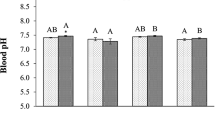Abstract
The red cell concentrations of ATP and GTP were investigated in Tilapia nilotica in normal and hypoxic waters. Reduction of water oxygen content diminished the cellular concentrations of both organophosphates. The concentration of ATP fell by about 70% of its normoxic values (2.4 ± 2.6 µ mol Pi 100 ml) at an O2 concentration of 4.5 mg l−1 in the water; further reductions of aquatic oxygen levels were not associated with significant changes in cellular ATP. Normal cellular levels of GTP (25.8 ± 2.7 µ mol Pi: 100 ml RBC) decreased progressively with advanced hypoxia especially at critical aquatic O2 concentrations. The ratio of the concentrations of ATP:GTP (2.4:1) in normoxic water decreased with hypoxia till it approached the equivalence in water of less than 5.5 mg l−1 O2. It is suggested that ATP is more important in modulation of blood oxygen affinity during mild or transient hypoxia and that GTP exerts its regulatory action over a wider range of aquatic O2 concentrations.
Similar content being viewed by others
References
Babiker, M. M., 1979. Respiratory behaviour, oxygen consumption and relative dependence on aerial respiration in the African lungfish (Protopterus annectens, Owen) and on airbreathing teleost (Clarias lazera, C.). Hydrobiologia 65: 177–187.
Babiker, M. M., 1984. Adaptive respiratory significance of organ ophosphates (ATP & GTP) in air-breathing fishes. Hydrobiol. 110: 339–349.
Bartlett, G. R., 1959a. Human red cell glycolytic intermediates. J. Biol. Chem. 234: 449–458.
Bartlett, G. R., 1959b. Phosphorus assay in column chromatography. J. Biol. Chem. 224: 466–468.
Bartlett, G. R., 1968. Phosphorus compounds in the human erythrocyte. Biochim. biophys. Acta 156: 221–238.
Bartlett, G. R., 1978a. Water soluble phosphates of fish red cells. Can. J. Zool. 56: 870–877.
Bartlett, G. R., 1978b. Phosphates in red cells of two south American Osteoglossids: Arapaima gigas and Osteoglossum bicirrhosum. Can. J. Zool. 56: 878–881.
Bartlett, G. R., 1978c. Phosphates in red cells of two lungfish: the south American Lepidosiren paradoxa, and the African, Protopterus aethiopicus. Can. J. Zool. 56: 882–886.
Gillens, R. G. & A. Riggs, 1971. The haemoglobin of fresh-water teleost, Cichlasoma cyanoguttatum (B. & G.), The effects of phosphorylated organic compounds upon the oxygen equilibria. Comp. biochem. Physiol. 38B: 585–595.
Gillens, R. G. & A. Riggs, 1973. Structure and function of the American eel, Anguilla rostrata. J. Biol. Chem. 248: 1961–1969.
Isaacks, R. E., H. D. Kim & D. R. Harkness, 1978. Relationship between phosphorylated metabolic intermediates and whole blood oxygen affinity in some air-breathing and water-breathing teleosts. Can. J. Zool. 56: 887–890.
Johansen, K., G. Lykkeboe, R. E. Weber & G. M. O. Maloiy, 1976. Respiratory properties of blood in awake and estivating lungfish, Protopterus amphibius. Resp. Physiol. 27: 335–345.
Johansen, K., C. P. Mangum & G. Lykkeboe, 1978. Respiratory properties of the blood of Amazon fishes. Can. J. Zool. 56: 898–906.
Magid, A. M. A. & M. M. Babiker, 1975. Oxygen consumption and respiratory behaviour of three Nile fishes. Hydrobiologia 46: 359–367.
Smit, G. L. & J. Hatting, 1981. The effects of hypoxia on haemoglobins and ATP levels in three freshwater fish species. Comp. biochem. Physiol. 68A: 519–521.
Weber, R. E., G. Lykkeboe & K. Johansen, 1975. Biochemical aspects of the adaptation of Hb-O2 affinity of eels to hypoxia. Life Science 17: 1345–1349.
Weber, R. E., G. Lykkeboe & K. Johansen, 1976a. Physiological properties of eel haemoglobin: hypoxic acclimation, phosphate effects and multiplicity. J. exp. Biol. 64: 75–88.
Weber, R. E., S. C. Wood & J. P. Lomholt, 1976b. Temperature acclimation and oxygen-binding properties of blood and multiple haemoglobins of rainbow trout. J. exp. Biol. 65: 333–348.
Wood, S. C. & K. Johansen, 1972. Adaptations to hypoxia by increased HbO2 affinity and decreased red cell ATP concentration. Nature 237: 278–279.
Wood, S. C., K. Johansen & R. E. Weber, 1975. Effects of ambient phosphate on haemoglobin-O2 and red cell ATP concentrations in a benthic fish, Pleuronectens platessa. Resp. Physiol. 25: 259–267.
Author information
Authors and Affiliations
Rights and permissions
About this article
Cite this article
Babiker, M.M. Role of organophosphates in adaptations of an obligate water-breathing teleost (Tilapia nilotica L.) to hypoxia. Hydrobiologia 121, 59–64 (1985). https://doi.org/10.1007/BF00035230
Received:
Revised:
Accepted:
Issue Date:
DOI: https://doi.org/10.1007/BF00035230




